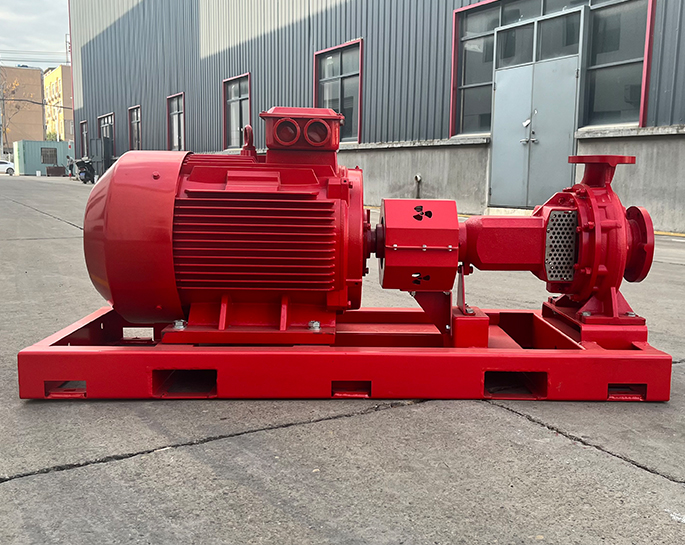How is the compatibility of fire pumps with fire-resistant fluids ensured?
Jan 03, 2024
Share:
Ensuring the compatibility of fire pumps with fire-resistant fluids is crucial for the proper functioning of fire suppression systems. Fire-resistant fluids are used in environments where traditional water-based systems may be ineffective or pose a risk, such as in areas with flammable liquids or electrical equipment. Here are some key considerations to ensure compatibility:
1. **Material Compatibility:**
- Fire pumps and associated components, such as seals, gaskets, and hoses, should be made of materials that are compatible with the specific fire-resistant fluid being used. Some fire-resistant fluids can be corrosive or reactive with certain materials, so it's important to choose materials that resist degradation.
2. **Fluid Properties:**
- Understanding the physical and chemical properties of the fire-resistant fluid is essential. This includes factors such as viscosity, density, and temperature stability. Fire pumps need to be designed to handle the specific characteristics of the fluid to ensure efficient operation.
3. **System Testing and Certification:**
- Fire pumps and systems should undergo rigorous testing to ensure compatibility with fire-resistant fluids. Certification by relevant regulatory bodies is often required to verify that the system meets specific safety standards. This may include tests for durability, performance, and chemical compatibility.
4. **Manufacturer Recommendations:**
- Follow the recommendations provided by the manufacturer of the fire-resistant fluid and the fire pump. Manufacturers often provide guidelines on compatible materials, operating conditions, and maintenance procedures. Deviating from these recommendations can compromise the effectiveness of the system.
5. **Seal and O-ring Selection:**
- Seals and O-rings are critical components in fire pumps, and they must be compatible with the fire-resistant fluid to prevent leaks. Selecting the right type of seals and O-rings that resist chemical attack from the fluid is crucial for maintaining the integrity of the system.
6. **Regular Maintenance and Inspection:**
- Implement a regular maintenance schedule for the fire pump and associated components. Periodic inspections can help identify any signs of degradation or wear, allowing for timely replacement of parts to ensure continued compatibility with the fire-resistant fluid.
7. **Training and Documentation:**
- Ensure that personnel responsible for operating and maintaining the fire suppression system are well-trained and have access to documentation regarding the compatibility of the fire pump with the specific fire-resistant fluid. This includes emergency procedures in case of a system failure.
By considering these factors and adhering to manufacturer recommendations and industry standards, the compatibility of fire pumps with fire-resistant fluids can be ensured, providing reliable and effective fire protection in various environments.

1. **Material Compatibility:**
- Fire pumps and associated components, such as seals, gaskets, and hoses, should be made of materials that are compatible with the specific fire-resistant fluid being used. Some fire-resistant fluids can be corrosive or reactive with certain materials, so it's important to choose materials that resist degradation.
2. **Fluid Properties:**
- Understanding the physical and chemical properties of the fire-resistant fluid is essential. This includes factors such as viscosity, density, and temperature stability. Fire pumps need to be designed to handle the specific characteristics of the fluid to ensure efficient operation.
3. **System Testing and Certification:**
- Fire pumps and systems should undergo rigorous testing to ensure compatibility with fire-resistant fluids. Certification by relevant regulatory bodies is often required to verify that the system meets specific safety standards. This may include tests for durability, performance, and chemical compatibility.
4. **Manufacturer Recommendations:**
- Follow the recommendations provided by the manufacturer of the fire-resistant fluid and the fire pump. Manufacturers often provide guidelines on compatible materials, operating conditions, and maintenance procedures. Deviating from these recommendations can compromise the effectiveness of the system.
5. **Seal and O-ring Selection:**
- Seals and O-rings are critical components in fire pumps, and they must be compatible with the fire-resistant fluid to prevent leaks. Selecting the right type of seals and O-rings that resist chemical attack from the fluid is crucial for maintaining the integrity of the system.
6. **Regular Maintenance and Inspection:**
- Implement a regular maintenance schedule for the fire pump and associated components. Periodic inspections can help identify any signs of degradation or wear, allowing for timely replacement of parts to ensure continued compatibility with the fire-resistant fluid.
7. **Training and Documentation:**
- Ensure that personnel responsible for operating and maintaining the fire suppression system are well-trained and have access to documentation regarding the compatibility of the fire pump with the specific fire-resistant fluid. This includes emergency procedures in case of a system failure.
By considering these factors and adhering to manufacturer recommendations and industry standards, the compatibility of fire pumps with fire-resistant fluids can be ensured, providing reliable and effective fire protection in various environments.


.png)
.png)

.png)


